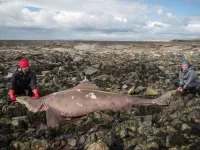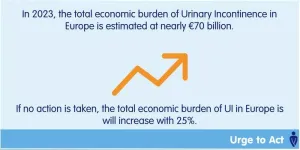(Press-News.org) The number of very premature babies (22 weeks) given respiratory life support (survival focused care) and/or admitted to neonatal units in England and Wales has increased 3-fold, following changes in 2019 to national guidance, finds research published in the open access journal BMJ Medicine.
While the proportion of these babies surviving to discharge has also increased, overall survival remains low, and there are “major implications for additional resource needs,” highlight the researchers.
The updated national guidance from the British Association of Perinatal Medicine focuses on a risk based approach, setting out various pregnancy and birth factors that should inform decision making and parental discussions for premature babies, including those born at 22 weeks. But its impact on neonatal care provision hasn’t been evaluated.
The researchers therefore drew on retrospective data from two national datasets in England and Wales: MBRRACE-UK and the National Neonatal Research Database (NNRD) from January 2018 to December 2021.
Between them, these datasets include: all live births from 22 weeks onwards In England and Wales: data on those who die before, during, and within 28 days of birth; and details of care provision and outcomes up to NHS hospital discharge.
The researchers focused on survival to admission for neonatal care; length of neonatal unit stay in days; survival to discharge home or to other healthcare settings; and survival to discharge without major health issues, such as retinopathy (eye disease) of prematurity and severe brain injury.
Overall, 5623 premature babies were born at 22-24 weeks, 1604 of whom were stillborn. Of the 4019 babies alive when care was started in labour, 1001 (25%) were born at 22 weeks, 1380 (34%) at 23 weeks, and 1638 (41%) at 24 weeks.
Among those alive at the start of labour at 22 weeks, the number and percentage receiving respiratory life support tripled from 59 out of 524 (11%) in 2018-19 to 183 out of 477 (38%) in 2020-21.
Similarly, admissions to neonatal units for babies alive at the start of labour at 22 weeks rose from nearly 7.5% to just over 28% while survival to discharge from neonatal care rose from 2.5% (13 babies) to just over 8% (39).
The numbers of these babies admitted to neonatal care units who died before discharge also increased from 26 to 95.
This may be because the characteristics of those receiving respiratory life support changed between 2018-19 and 2020-21, with increases in smaller–weighing under 500g–(46% vs 64%), and more immature—born in the earlier part of the 22nd week—(19% vs 31%) babies, say the researchers.
The total number of care days provided to all babies born at 22 weeks increased, rising from 2535 in 2018-19 (1268/year) to 6840 in 2020-21 (3420/year).
This is an observational study, and the researchers acknowledge various limitations to their findings. For example, their definition of survival focused care was mainly limited to provision of active respiratory care because this information was uniformly available. And they were only able to assess short term outcomes.
But they say: “Our analysis suggests that these rapid and substantial changes were associated with the introduction of the British Association of Perinatal Medicine guidance.
“Although the recommendation was intended to be risk based, we speculate that, on the contrary, approaches have moved from being selective to more widespread provisions of survival focused care. This change would explain the increase in the proportion of babies at high risk who received survival focused care.”
They conclude: “While survival for babies born at 22 weeks remains low, the numbers receiving survival focused care and being admitted to neonatal units has tripled. Although this finding suggests that the total number of survivors has increased, this result also means that the number of babies who died after intensive care also increased.
“Maternity care was also affected because of likely increases in in-utero transfers (ie, moved to a specialist hospital before birth), as well as impacts on paediatric and educational services to provide for long term health and developmental needs. This change represents an important increase in workload and need for specialised health care and educational resources.”
As clinical experience caring for this vulnerable group of babies grows, more international research is needed to improve outcomes and identify early prognostic factors so that prolonged intensive care can be avoided for babies who are unlikely to survive, they add.
END
Three-fold rise in babies born at 22 weeks given respiratory life support in England and Wales after guidelines change
Rise in proportion surviving to discharge, but overall survival remains low. And there are major implications for additional resource needs, say researchers
2023-11-08
ELSE PRESS RELEASES FROM THIS DATE:
Why a surprising discovery, warming seas and the demise of the ‘Meg’ may spell trouble for more and more sharks
2023-11-08
Some unexpected shark strandings and subsequent surprises following autopsies have, ironically, taken marine biologists millions of years back in time as they look to the future with concern. Adding chapters to an evolutionary tale involving the infamous megalodon shark (the “Meg”), they think their work suggests there are more warm-blooded sharks out there than previously believed, and – based on the Meg’s demise – these species may be at great risk from warming seas.
Some of the most ...
The annual economic burden of urinary incontinence could reach €87 billion in 2030 if no action is taken
2023-11-08
Brussels, 8 November 2023 – New international research on the economic burden of urinary incontinence reveals that the cost of continence care will reach an estimated €69.1 billion in 2023. These costs include the impact of incontinence on individuals’ health, the costs of medical consultations and products such as continence pads, incontinence-related absenteeism at work, nursing home admissions, and the environmental impact of incontinence care. If no action is taken to support continence health, the economic burden could rise by 25% in 2030, to €86.7 billion. This economic burden becomes considerably higher when including caregiver costs.
Some 55-60 million ...
Researchers say AI model accurately identifies, predicts joint damage in hand X-rays
2023-11-07
ATLANTA — New research at ACR Convergence 2023, the American College of Rheumatology’s (ACR) annual meeting, shows that a deep learning system could accurately identify and predict joint space narrowing and erosions in hand radiographs of patients with rheumatoid arthritis (RA) (Abstract #0745).
Radiographs are the most commonly used imaging technique for detecting and monitoring RA in the hand. Radiologists frequently use the well-validated Sharp/van der Heidje (SvH) method to evaluate joint space ...
Study finds acute calcium pyrophosphate deposition arthritis doubles fracture risk
2023-11-07
ATLANTA - Researchers will present the first-ever study of fractures and calcium pyrophosphate deposition disease at ACR Convergence 2023, the American College of Rheumatology’s (ACR) annual meeting. They report a doubled risk of fractures in patients with acute calcium pyrophosphate crystal arthritis compared to those without the disease (Abstract #0235).
Calcium pyrophosphate deposition (CPPD) disease occurs when calcium pyrophosphate (CPP) crystals form near cartilage cells, and sometimes leads to joint inflammation, pain, and swelling. It has often been called pseudogout because ...
Education key to curbing antimicrobial resistance in cats
2023-11-07
ITHACA, N.Y. -- Better education for cat owners, more communication from veterinarians, increased drug choices and cheaper, rapid diagnostic tools can help improve antimicrobial use in cats, which has important implications for rising antimicrobial resistance in animals and humans, according to two new papers by Cornell researchers.
Antimicrobial resistance threatens up to 10 million human lives a year and may cost the global economy trillions of dollars, with resistant pathogens moving easily between humans and animals, according to the papers’ authors.
In one paper, “Divergent Veterinarian and Cat ...
New compound shows early promise for treatment of Lou Gehrig’s disease in preclinical models
2023-11-07
In science, a simple but thorough observation can kick-start the most surprising findings. Researchers at the Hollings Cancer Center at the Medical University of South Carolina noticed that mice lacking a protein of interest in cancer research were showing visible signs of abnormal motor functions as they aged, including loss of coordination and strength. The team showed that that lack of this protein resulted in the accumulation of damaged mitochondria that affected motor function. Treating these mice with a drug that triggered the destruction of damaged mitochondria restored their motor ...
Diverse task force develops new quality measures to improve lupus care by 2030
2023-11-07
ATLANTA — Leaders of a project to develop and implement equitable new quality measures for lupus care by the end of the decade will present their work at ACR Convergence 2023, the American College of Rheumatology’s (ACR) annual meeting (Abstract #1899).
Systemic lupus erythematosus (SLE, lupus) is an autoimmune disease marked by adaptive immune system activation, formation of autoantibodies, and systemic inflammation affecting organ systems throughout the body. Lupus disproportionately affects women and people of color, who are more likely to have severe ...
Study finds low anti-Ro titers are not associated with fetal heart block
2023-11-07
ATLANTA - New research from an ongoing study that will be presented at ACR Convergence 2023, the American College of Rheumatology’s (ACR) annual meeting, shows that pregnant women with very low titers of anti-Ro antibodies are at minimal to no risk of fetal atrioventricular (AV) block, a serious disorder affecting the heart’s electrical system.
After birth, fetal AV block requires lifelong pacemaker treatment or cardiac transplantation and may be fatal. However, pregnant patients with higher titer antibodies seem to be at greatest risk at risk ...
Study finds hydroxychloroquine lowers risk of nonalcoholic fatty liver disease in rheumatoid arthritis patients
2023-11-07
ATLANTA - New research at ACR Convergence 2023, the American College of Rheumatology’s (ACR) annual meeting, shows that treating rheumatoid arthritis with hydroxychloroquine (HCQ) reduced the risk of nonalcoholic fatty liver disease, especially in women and men who are 50 years old and younger (Abstract #0396).
Rheumatoid arthritis (RA) is a systemic autoimmune inflammatory disease marked by chronic joint inflammation leading to joint damage and loss of function. It can also affect tissues and organs outside the joints, including (but not limited to) the eyes, ...
Study shows saliva gland abnormalities in Sjögren's worsens over time
2023-11-07
ATLANTA - New research at ACR Convergence 2023, the American College of Rheumatology’s (ACR) annual meeting, shows that ultrasound-detected salivary gland abnormalities in primary Sjögren's become more severe over time and that the slow-to-progress disease likely starts long before it is first detected (Abstract #1371).
Sjögren's disease also known as Primary Sjögren’s syndrome, is a systemic autoimmune disorder. It is marked by inflammation of the lacrimal and salivary glands, leading to chronic dry eyes and mouth. Fatigue is common, ...
LAST 30 PRESS RELEASES:
Estimating unemployment rates with social media data
Climate policies can backfire by eroding “green” values, study finds
Too much screen time too soon? A*STAR study links infant screen exposure to brain changes and teen anxiety
Global psychiatry mourns Professor Dan Stein, visionary who transformed mental health science across Africa and beyond
KIST develops eco-friendly palladium recovery technology to safeguard resource security
Statins significantly reduce mortality risk for adults with diabetes, regardless of cardiovascular risk
Brain immune cells may drive more damage in females than males with Alzheimer’s
Evidence-based recommendations empower clinicians to manage epilepsy in pregnancy
Fungus turns bark beetles’ defenses against them
There are new antivirals being tested for herpesviruses. Scientists now know how they work
CDI scientist, colleagues author review of global burden of fungus Candida auris
How does stroke influence speech comprehension?
B cells transiently unlock their plasticity, risking lymphoma development
Advanced AI dodel predicts spoken language outcomes in deaf children after cochlear implants
Multimodal imaging-based cerebral blood flow prediction model development in simulated microgravity
Accelerated streaming subgraph matching framework is faster, more robust, and scalable
Gestational diabetes rose every year in the US since 2016
OHSU researchers find breast cancer drug boosts leukemia treatment
Fear and medical misinformation regarding risk of progression or recurrence among patients with breast cancer
Glucagonlike peptide-1 receptor agonists and asthma risk in adolescents with obesity
Reviving dormant immunity: Millimeter waves reprogram the immunosuppressive microenvironment to potentiate immunotherapy without obvious side effects
Safety decision-making for autonomous vehicles integrating passenger physiological states by fNIRS
Fires could emit more air pollution than previously estimated
A new way to map how cells choose their fate
Numbers in our sights affect how we perceive space
SIMJ announces global collaborative book project in commemoration of its 75th anniversary
Air pollution exposure and birth weight
Obstructive sleep apnea risk and mental health conditions among older adults
How talking slows eye movements behind the wheel
The Ceramic Society of Japan’s Oxoate Ceramics Research Association launches new international book project
[Press-News.org] Three-fold rise in babies born at 22 weeks given respiratory life support in England and Wales after guidelines changeRise in proportion surviving to discharge, but overall survival remains low. And there are major implications for additional resource needs, say researchers


